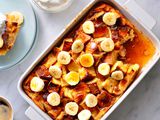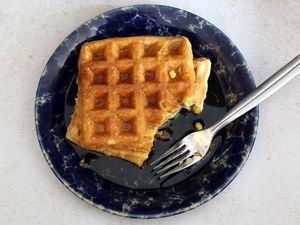:max_bytes(150000):strip_icc()/dutch-baby-recipe-7092386-hero-04-65e42dd61f5347b8800a4ef04c904d59.jpg)
The Spruce Eat / Bahareh Niati
When it comes to easy but impressive brunch dishes, Dutch babies are hard to beat. They come together with minimal ingredients, are easy to make even if you’re groggy and moving slow, and they make a beautifully browned, puffy brunch centerpiece that can be sweet or savory.
The Origin of the Dutch Baby
Dutch babies are likely a take on German pancakes (pfannkuchen) and are commonly attributed to Manca’s Café, a Seattle restaurant that has long since closed its doors. The “Dutch” in Dutch baby is probably derived from the word deutsch, meaning “German.”
Whatever the origin, these pancakes are notable for their gravity-defying puff. They have a very light, airy texture thanks to an egg-rich batter. In this way, Dutch babies are similar to popovers or Yorkshire puddings, but Dutch babies are served as a large pancake vs. small individual breads.
How to Make the Best Dutch Baby
While Dutch babies are super simple to make, there are a few best practices for achieving the perfect puff.
- Whisk or blend the batter together quickly, right before using it. The batter can sit for a while before making the pancake, and you can even refrigerate it overnight. However, there is no advantage to making the batter ahead as you get a slightly better puff from room temperature batter.
- It is tempting to add shredded cheese, vegetables, or berries directly to the Dutch baby batter, but I don’t recommend it as it compromises the puff. Very small additions like fresh herbs or black pepper are fine to add to the batter. That said, it’s really hard to mess up a Dutch baby so you’ll likely wind up with something delicious no matter what.
- Get that skillet hot! Putting the skillet in the oven as it preheats means that the Dutch baby batter will start cooking and puffing the second it hits the pan, giving you a bigger, better puff.
Is a Dutch Baby the Same as Yorkshire Pudding?
Dutch babies and Yorkshire puddings are very similar. The main differences are that Dutch babies are usually served sweet, and Yorkshire puddings are almost always served savory; Dutch babies are baked in a large skillet, and Yorkshire puddings are typically baked in individual servings; Finally, Dutch babies use butter as the fat, and Yorkshire puddings are made with beef drippings, usually as an accompaniment to a beef roast.
How to Serve a Dutch Baby
Dutch babies need little accompaniment, but they are also a fantastic blank canvas for all kinds of treatments, sweet and savory alike. The classic way to serve a Dutch baby is with a generous dusting of powdered sugar and the juice of a lemon wedge spritzed on top. But you can serve them like pancakes, with maple syrup and butter or your favorite fruit compote.
I love a savory Dutch baby, so I often top mine with sautéed greens and fried eggs. See the recipe variations below for a host of ways to customize your Dutch baby.
Tips for Making a Dutch Baby
- Warm up the eggs—To bring eggs to room temperature quickly, gently place them in a drinking glass and add very warm tap water to cover. Let them sit for 5 to 10 minutes. To bring the milk to room temperature, measure it into a microwave-safe (glass or plastic) liquid measuring cup and microwave it on full power for 20 to 30 seconds or until warm, not hot, to the touch.
- How to serve—To serve the Dutch baby, you can share it right out of the skillet, but be careful, as the skillet will be very hot. You can also slide the Dutch baby onto a cutting board, cut it in half, and serve it on warmed plates.
- Use a blender—Instead of whisking the batter in a bowl, you can add all the ingredients to a blender and blend them until smooth, 15 to 20 seconds.
- Make a sweeter pancake—This Dutch baby contains no sweetener, which makes it versatile, but if you would like a sweeter pancake, add 2 tablespoons granulated sugar to the batter.
- The texture is up to you—For a softer Dutch baby, bake the pancake for the lower amount of time (a softer Dutch baby will also collapse faster). For a Dutch baby with crisp edges and that will hold its shape better, bake the pancake for the longer amount of time.
"Dutch Baby Pancake is one of my most favorite things for brunch. They are very easy to make and require minimum ingredients but there are some key elements to it. Make sure the ingredients are in room temperature and the oven is hot, and you’re good to go! I love how simple and classic this recipe is and you can serve it with any topping that you desire, savory or sweet." —Tara Omidvar
:max_bytes(150000):strip_icc()/DutchBaby-Tara-Omidvar-2023-0bef12df586c4dda96e0813a59226ca0.jpg)
Ingredients
-
1/2 cup (130 grams) milk, at room temperature
-
2 large eggs, at room temperature
-
1/4 teaspoon fine salt
-
1/2 cup (65 grams) all-purpose flour
-
2 tablespoons unsalted butter
-
Powdered sugar, for serving
-
Lemon wedges, for serving
Steps to Make It
-
Gather the ingredients. Preheat the oven to 425 F with a 10-inch cast-iron skillet inside.
![Ingredients to make a Dutch baby]()
The Spruce Eat / Bahareh Niati
-
Whisk together the milk, eggs, and salt in a medium bowl.
![A bowl of whisked milk, eggs, and salt]()
The Spruce Eat / Bahareh Niati
-
Whisk in the flour to make a mostly smooth batter (a few lumps are ok).
![Flour added to the milk-egg mixture]()
The Spruce Eat / Bahareh Niati
-
Add the butter to the hot skillet and swirl the butter around to coat the bottom and halfway up the sides of the pan.
![Two pieces of butter melting in a hot skillet]()
The Spruce Eat / Bahareh Niati
-
Pour the batter into the skillet and return the pan to the oven immediately. Bake for 15 to 20 minutes or until the pancake is puffed and deep golden brown.
![A cooked Dutch baby in a skillet]()
The Spruce Eat / Bahareh Niati
-
Serve the pancake hot, sprinkled liberally with powdered sugar and lemon juice to taste.
![A Dutch baby topped with fresh lemon juice and powdered sugar]()
The Spruce Eat / Bahareh Niati
Feeling Adventurous? Try This:
Dutch babies are incredibly versatile and can be served sweet or savory.
Top a sweet Dutch baby with:
- Maple syrup and butter
- Warmed jam, jelly, or preserves
- Fried apples with cinnamon
- Powdered sugar and fresh fruit
- Fresh blueberry sauce
For a savory Dutch baby, do not serve with powdered sugar and lemon juice. Top with:
- Sautéed mixed greens and fried eggs
- Canadian bacon, poached eggs, and hollandaise sauce
- Thinly sliced gravlax, crème fraîche, pickled red onions, and capers
- Sautéed mushrooms and fried or poached eggs
| Nutrition Facts (per serving) | |
|---|---|
| 453 | Calories |
| 19g | Fat |
| 68g | Carbs |
| 16g | Protein |
| Nutrition Facts | |
|---|---|
| Servings: 2 | |
| Amount per serving | |
| Calories | 453 |
| % Daily Value* | |
| Total Fat 19g | 24% |
| Saturated Fat 10g | 49% |
| Cholesterol 222mg | 74% |
| Sodium 375mg | 16% |
| Total Carbohydrate 68g | 25% |
| Dietary Fiber 10g | 37% |
| Total Sugars 20g | |
| Protein 16g | |
| Vitamin C 178mg | 891% |
| Calcium 202mg | 16% |
| Iron 4mg | 25% |
| Potassium 662mg | 14% |
| *The % Daily Value (DV) tells you how much a nutrient in a food serving contributes to a daily diet. 2,000 calories a day is used for general nutrition advice. | |
Recipe Tags:

:max_bytes(150000):strip_icc()/dutch-baby-recipe-7092386-step-01-8c44c257373d4ef2ba3140a7aca77295.jpg)
:max_bytes(150000):strip_icc()/dutch-baby-recipe-7092386-step-02-b18310d1c07746f8881f2224defaee98.jpg)
:max_bytes(150000):strip_icc()/dutch-baby-recipe-7092386-step-03-8eef352d25ea45b494bfc44580d4068c.jpg)
:max_bytes(150000):strip_icc()/dutch-baby-recipe-7092386-step-04-e34c8959305047329a323c480f7c55d3.jpg)
:max_bytes(150000):strip_icc()/dutch-baby-recipe-7092386-step-05-498b1f6775be48b084ff082e4c8546c1.jpg)
:max_bytes(150000):strip_icc()/dutch-baby-recipe-7092386-step-06-b1f599434f6040ffa8c335ac6396aab7.jpg)












































